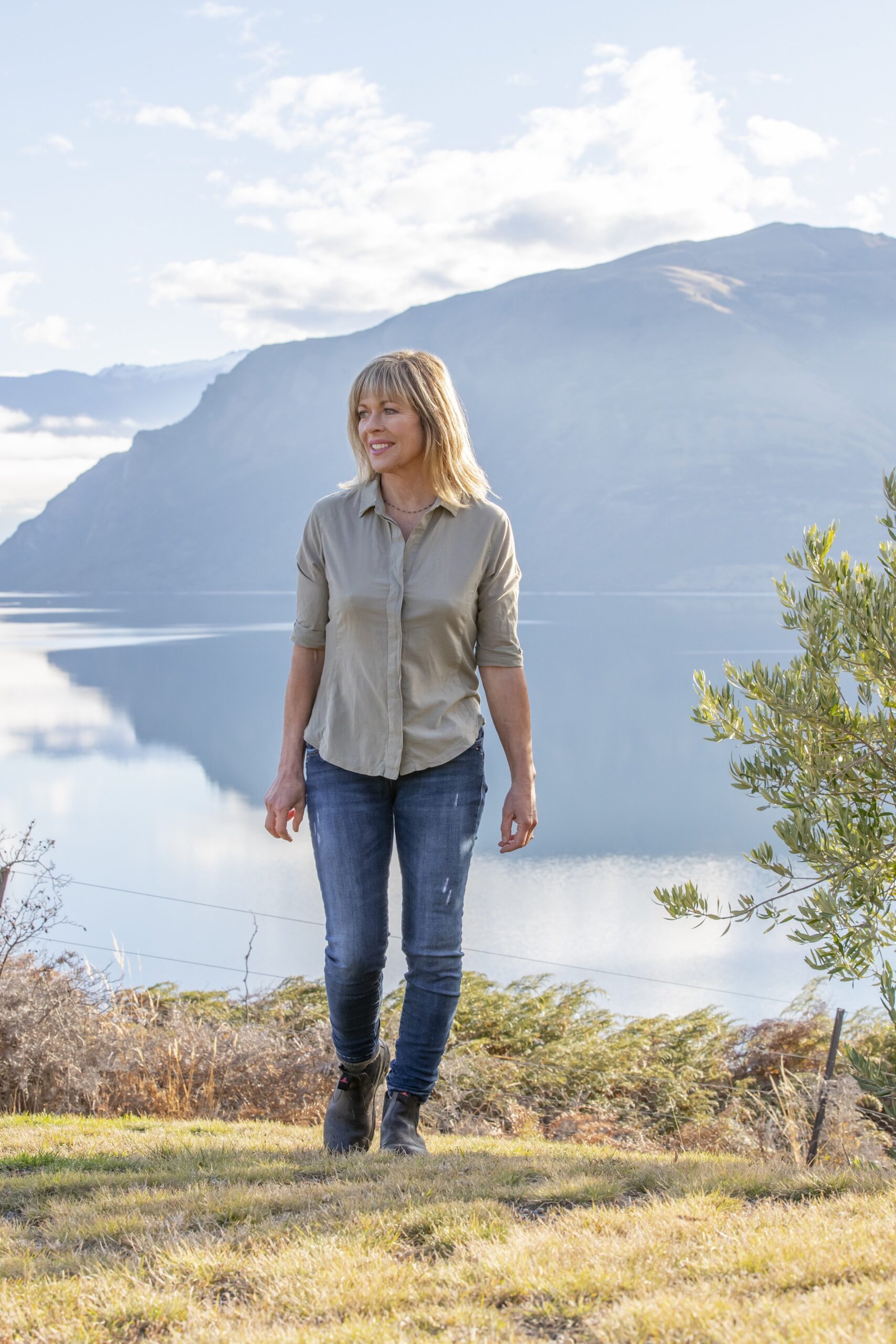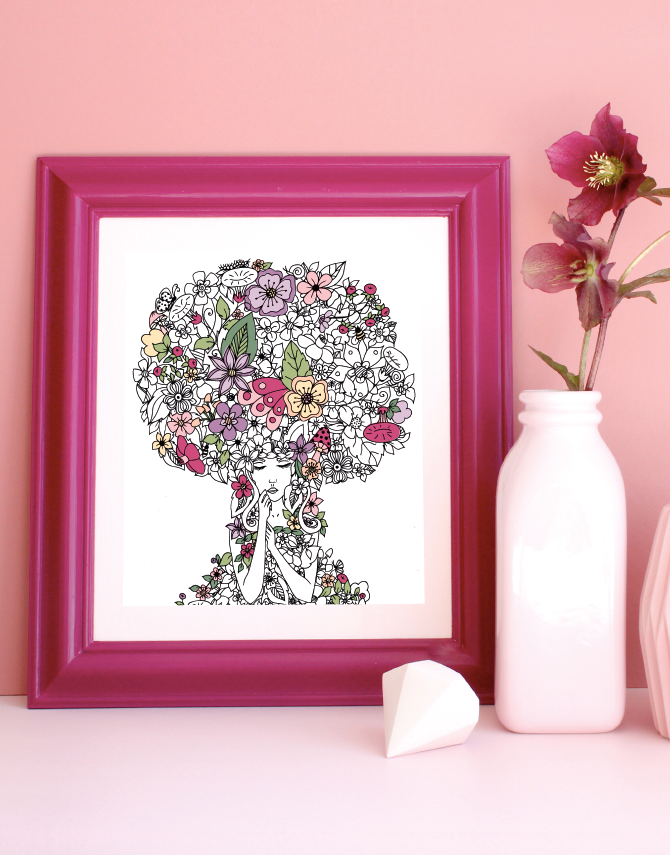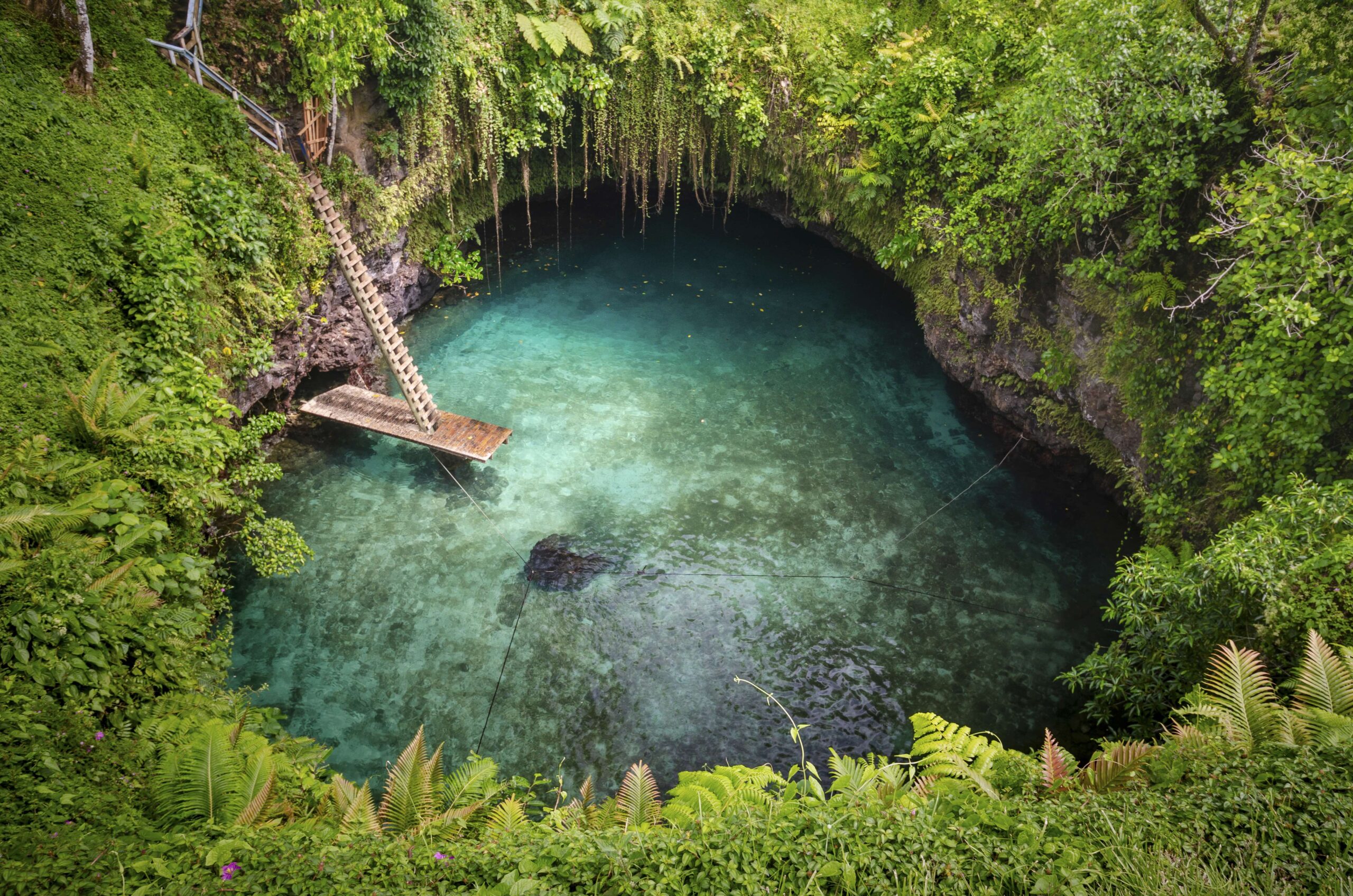Photography Aliscia Young.
Annabel Langbein shares her top tips for gardening – north and south – from her home in Wanaka.
Nothing gives Annabel Langbein more pleasure than growing her own food.
She’s been doing it since she was a hippie living up the Whanganui River at age 17 and since that golden time, it’s been a passion that has become a lifestyle.
Since making the permanent move to Wanaka from Auckland four years ago, she’s never been happier. “Living off the land is a lot of hard work but it’s also fun. It’s a very engaged physical life. My life is busier now and I’m fitter,” she says.
The lakeside 27-acre property that Langbein and husband Ted have owned since 1996 is now a swamp-free mecca with a beautiful garden as well as a view over the lake. Planted out with trees over the years on frequent family holidays south, Langbein admits Ted had a vision.
“He bought it without telling me. We were married and had small children and honestly I wanted to kill him. ‘What do you mean you’ve bought a bog on the side of the lake?’ It was just bracken, blackberry and rosehips. I looked at this land and I thought you have to be mad. And honestly, it was a feud for months. I was just furious with him because we didn’t have any money,” she says.
“And now I’m the luckiest person in the world because he had the vision and it’s absolutely gorgeous. So I have to be very humble and say ‘thank you’.”
While most people – north and south – give up on gardening over winter, Langbein’s vegetable garden has fed the family through the colder months.
“We’ve seen winter all the way through without having to buy vegetables. I’ve got rocket, lettuce, mâche, Brussels sprouts and broccoli – which I covered up so it wouldn’t freeze – beetroot and carrots. In the store, I’ve got garlic, onions and potatoes. There’s about 32 different plants that I can grow here during winter,” she says.
With a diploma in horticulture, Langbein understands the cycles and seasons of plants, and knowing daughter Rose and her boyfriend were homeward bound from New York, she planted a big winter garden in February.
Rose and Langbein produced Together which won a best book award at The Foodies NZ Food Media Awards in 2019.
A foodie, Rose, 27, shares her mother’s love of cooking but not gardening, though she is learning.
“It was so funny because Rose came home and she’d been shopping at Eataly in New York, being able to go and buy burrata and heads of radicchio so she’d go to the garden and get whatever the plant was and cut the whole thing off. And I was like, ‘oh no, no, no, because then you won’t have any more again. Only pick the outer leaves and then the middle leaves can keep growing’,” laughs Langbein.
“It’s been really fun for her learning about gardening and growing, and then you actually value it more. You have this incredible sense of connection. I think that’s what gives me so much joy – you grow it, you look after it, and you harvest it, you cook it, you eat it. It’s a very connected feeling and it’s also something which requires you to be very present in your life. And I think that that’s something we’re all seeking and in this world where everyone’s got so much anxiety and angst and pressure, valuing it and giving yourself permission to spend some time in the garden, to spend some time cooking, it’s very nourishing. And it’s quite physical as well, if you are out in the garden. You don’t need a gym membership, you can just go out and dig.”
When to plant
Now is the perfect time to plant a vegetable garden, advises Langbein. Don’t wait until Labour Weekend, otherwise most of your garden produce will be ready when you’re away on your summer holiday!
There is no reason why you can’t plant a lot earlier in September, as well as planting two weeks later than you normally would do. That way, you’ve given yourself a bigger window.
Also, it’s a good idea to know where it’s going to be sunny for the longest time during the day, “because pretty much everything that you plant in spring is going to be happy in the sun”. And later on, if it gets really hot, you’ll want some shady spots to put things like rocket.
The soil should be well drained, so if you have clay, you’re better to do raised beds and add soil – and don’t forget the weed mat. “You’re much better to deal with it at the start because once you’ve got couch in your beds, you’re going to be fighting with that grass forever.”
If you have a number of raised beds, she suggests growing brassicas in one, leafy greens in another, have a separate one for potatoes and if you live in the north, one for chillies, tomatoes and peppers.
And set up an automatic watering system, or all your hard work will be in vain.
Rotating the beds each season is also important otherwise you will get disease or bugs will coming in. After potatoes, she suggests planting leguminous vegetables like snow peas or beans, which add nitrogen to the soil, and after that, brassicas, which will use that nitrogen.
“Keep those cycles going, though last year I looked and realised I’d planted potatoes and brassicas everywhere so I really mucked up my whole flow chart planning there,” she laughs.
Choosing what to plant
“The first thing to ask yourself is ‘what do I like eating?’” says Langbein. “Because there’s no point in growing radishes if no one in the family is going to eat them.
“And if you haven’t got a lot of room then grow things that don’t take up a lot of room and are also expensive. So instead of paying $3.99 for a tiny bag of rocket, grow rocket or spinach because you’re always going to use those leafy greens. It’s so easy to grow and it’ll grow for about nine months of the year, and if you pick it high enough on the stem, you’ll get a second cut.”
Fennel is another expensive vegetable that’s easy to grow. Langbein likes cooking it in a pan with butter until it’s lightly brown and then adding stock and cooking it until it’s tender. “Then it sort of caramelises and is delicious with fish or chicken.”
Though avoid planting bronze fennel, she warns, as that is invasive and can take over your garden!

Spreading the love
Globe artichokes, which are pretty, or Jerusalem artichokes with their sunflower-like flowers, are both really useful architectural plants to have in the garden.
“They look really good in your perennial bed,” says Langbein.
“Make borders out of parsley and chives. And I always grow a lot of dahlias in my vegetable garden as they bring the beneficial insects. So you can kind of mix it up a bit. You can eat marigold flowers, which also keep insects away as well. And why not put asparagus in the perennial bed? Because the annoying thing about having asparagus in your garden bed is that it has to sit there for four to five years before it gets established and you can harvest it and it has beautiful flowering fluffy heads.”
Langbein has also hedged her bay tree to look like a Christmas tree, which means she has bay leaves as well as a tree for the festive time of year. Looking ahead to Christmas, she suggests making homemade gifts from what’s in season or what you have a surplus of.
“What’s really good right now is all the citrus and you could make your own yummy marmalade. I always put a cup of whiskey in my marmalade right at the end. It just gives it this delicious flavour,” she says. “Don’t go and use the family’s expensive whiskey, but a cup of whiskey at the end is fantastic. And then make a nice label and you’ve got a whole lot of Christmas presents already made.”
Another idea is making infused vodka.
“When berries come into season, you can just chuck a whole lot of raspberries into a bottle of vodka with some sugar or boysenberries or blackberries or currants. I made lots of cassis last year with currants, sugar and vodka. You need to leave it for quite a while for the colour and flavour to infuse, but it’s delicious.”
Langbein is also excited to be launching her own gin later this year with Arrowtown distillery Broken Heart Spirits.
The gin, named Bella, contains about 18 aromatics she’s spent years experimenting with and perfecting – and she has a shed full of different brews concocted as she’s worked towards finalising the recipe.
Life in food
Bella is also the title of her most recent book about her life in food.
She really enjoyed writing Bella, which is different from her cookbooks as it tells the story of her life as well as including some delicious recipes, of course. She loved the writing process and is considering writing some fiction.
Will there be another cookbook on the horizon? Actually, yes. She and Rose have collaborated on another book, Summer at Home, to be released later this month!
Country life
Rural living, even though Wanaka township is a 12-minute drive away, means that Langbein tends to use less, waste less and reuse things.
“I’ve always been a bit of a hippie at heart because I like the idea of the values around traditional hippiedom, which was about not wasting stuff and living a pretty simple, connected life. And I think it’s made me even more conscious of that and not in a sort of preachy, bossy way, but just hoping to show other people how you can do a lot with very little.”
She loves the sense of community, too, where neighbours look after one another, as well as the laid-back lifestyle, though she observes Wanaka is changing.
“You used to able to go into town in your gumboots having a bad hair day and I still do it. It doesn’t worry me, but there’s a lot of very elegant people walking around in high-heeled shoes. And I’m thinking, ‘what are you doing here?’”
She never has a typical day, though since moving south she’s taken up meditation and tries to do a meditation as well as some stretching each morning.
“I’m not very good at the winter. I don’t really go outside until after lunchtime. I have been known to stay in bed quite late working on my computer in the mornings,” she laughs.
What is a given is that she’ll be cooking for at least one or two hours each day.
“Somebody just sent me a whole lot of grapefruit, so I’m going to make some marmalade. And, I’m often fiddling round because suddenly you realise that you’ve got eight heads of broccoli that all need to be harvested at once, and then there won’t be any for X amount of time. So what are you going to do? You’re going to freeze it, which I never would’ve thought was a good idea but when I went to Antarctica, all they had was frozen broccoli. It was actually really good. Just blanch it and freeze it.”
Waste not want not
And if you have a bounty of limes or lemons, freeze those too because citrus are winter fruit, then in the middle of the summer when you want them, they’re not around.
“Cut the limes in segments and use instead of ice in your glass of gin and tonic,” advises Langbein. “Also, the outer zest is so fragrant. Sometimes if I can be bothered, I’ll take that outer zest off with a microplane and store it in the freezer in a container. Then later you can add a little pinch of it, like a pinch of saffron, to any Asian dish. It gives you that beautiful aromatic layering.”
And don’t throw out your ugly fruit or vegetables. “It’s really important not to get hung up on good looks, it’s like people,” she says.
“At the moment some of my stored apples are starting to go bad so I’m cutting out the bad bits and stewing the rest. The same with the potatoes. I cut off the green bits, which are really poisonous, and use the other bit because not to use it seems wasteful.”
Setting others up for success
Making food accessible for people so that they can easily be successful in the kitchen is one reason why Langbein’s recipes are so popular and that she has become a household name.
“I’m not a trained chef and I’ll always go for the shortcut that works rather than 12 steps,” she says.
Her cookbooks have been translated into nine different languages and proud moments include receiving a New Zealand Order of Merit for her services as a food writer, an honorary doctorate in commerce from Lincoln University (where she did her diploma in horticulture) and being recognised with a World Class New Zealander Kea Award.
“We got our TV series broadcast into 93 different countries and that made me feel really proud, but the sense of empowering people is what makes me feel the proudest, that anyone can do it, it isn’t rocket science. It’s one of the simplest things. People have been cooking for thousands of years and there’s always so much to learn and it’s a way that brings us together and connects us,” she says.
“I think it’s a very nourishing thing to do for yourself and also for other people because you can create a sense of home no matter where you’re living.”
Living in the spotlight
Langbein never thinks of herself as a household name, though she’s even had people recognise her on the plane in Turkey because of her television series.
“The nice thing about it is that it isn’t really about me. It’s about people coming up and telling you how happy they were with what they’ve done. And you’ve been the conduit for that. So that’s actually really nice, but I will tell you something funny,” she confides.
“I was visiting the chemist before the first lockdown. It was a Sunday and I had a bad hair day and a no make-up on, and my gumboots, filthy clothes and I just needed to rush in, and I don’t know whether it was for toothpaste or band-aids, I can’t remember. And as I was about to put my credit card on the counter, the woman said to me, ‘You know, has anyone ever told you, you look a bit like Annabel Langbein?’. And I thought, well, I’m not going to embarrass you because I’m about to give you my credit card. So I said, ‘well, I am Annabel Langbein’. And she looked so disappointed and said, ‘oh’. It burst her bubble that I wasn’t this glamorous lady behind the sink all the time.”

Hunter gatherer
Looking ahead to summer, Langbein is looking forward to taking some time out to go fishing, a favourite pastime, because you have to work for your dinner.
She is a big advocate of sustainable seafood and points out that around 92 species of seafood are commercially fished in New Zealand and yet most of us are only familiar with five or six.
“There’s a lot of pressure on blue cod and snapper, but in fact fresh warehou, kahawai, mullet – which people think of as a bait fish – is very good eating,” she says.
“Red cod is a great example. You’ll see it in the supermarket for $12 or $15 a kilo and everything else is at least $35 if not $45. It’s the most fantastic fish for ceviche because it’s really delicate. If you cook it, it’ll fall apart quite easily so it’s often good in Chinese cooking when you’re steaming it, but won’t handle being pan fried. But when you ceviche it, it’s delicious. Why buy an expensive fish when you don’t need to?”
Her advice for the best way to cook a freshly caught fish depends on the type you hook.
“We’re not a fishbone eating culture of people. In China, people can manage fishbones and conversations at the same time, whereas we choke and have to go to the hospital,” she says.
“So I think it depends on the species, because if it’s a pelagic fish, which means it’s very muscular, whether it’s tuna or kahawai, mackerel or trevally, which is really underrated, you can pan-fry it or ceviche it. They are often better to have raw. And when you have a bottom-dwelling fish, you get those lovely fish fillets, like blue nose or hāpuku, that are good to bake.
“If you’re only feeding two people, you can’t really go past crumb, butter, pan. Yum. But try doing that for eight people, it’s a nightmare. Keep it to one or two.”
Lessons from Antarctica
Travelling to “the ice” in 2017 at the invitation of Antarctica New Zealandwas a once in a lifetime experience and one that changed her more than she thought at
the time.
Aside from realising she could freeze broccoli, and learning how to survive in a snow blizzard, her conversations with scientists confirmed what she has always known in her heart – to respect the Earth.
One scientist she met had found fossilised beech tree leaves in the dry valleys where it hasn’t rained for 14 million years.
“They’ve also found, down the big valleys at the bottom, tropical plants, dinosaurs and huge palm trees, all fossilised. So at some point in time, in that part of the world, it was lush and green and hot, and it made me realise how we take for granted that we have this climate. We can see it changing so quickly, but in fact I don’t think we have any idea how dramatically the climate can change and that the planet will carry on, but we probably won’t.”
Recently, Langbein was also invited to be a keynote speaker at a soil science conference.
“I’m not a soil scientist, but the thing that was the most interesting for me was that the biology of the soil is very similar to the biology of our guts, in that to have a healthy soil that can allow a plant to pick up as many nutrients as possible, you need a really big sort of biome for want of a better word. And that biome is by having the widest range of microbes that you can. So building strong soil is as important as what you’re going to grow,” she says.
Room to grow
Throughout her career, husband Ted has been a constant support. In her book Bella, she dedicates a chapter to Ted, her “international man of mystery”. The first time she saw Ted was when she was poaching on his farm. He didn’t see her and it was years later that she fessed up.
Engaged in 1987 and married since 1991, their marriage has endured and she is grateful that even before then he’s had her back.
When she broke her back after falling off her horse when it bolted across a dry river bed, Ted, her then-boyfriend arranged a conference call with five back specialists in Auckland to seek the right advice for how to first move her and then the best recovery options.
“I feel incredibly lucky to be married to someone who’s very kind, he’s very clever and he isn’t at all jealous. He loves me being successful and being my best self or has enabled me to be the best version of myself,” she says.
“And I’d like to think that I’m enabling and continuing to enable him to be the best version of himself. So letting each other be and supporting and loving each other unconditionally. We have the same values, aligned interests and like simple things. And honestly, I think ‘how lucky am I to have someone who’s got my back all the time?’”
Epiphany
During her stint in the hospital, Langbein spent three months horizontal. She could still feel her fingers and toes, so she thanked her lucky stars. And it also gave her plenty of time to think about what she wanted to do with her life.
At that point, she was writing recipes for the Listener, had set up her own food agency The Culinary Institute of New Zealand and had published her first cookbook.
“I’d been going a million miles an hour and I wanted to do something that might make a difference in the world. I figured that cooking had made a difference in my life. So that was something. If I could share that and show people such simple pleasure can help you to feel connected and be present and have this sense of
love and nourishment that you can give to other people that makes them feel good as well… you can build a life around that and it isn’t all about money and stuff.”





